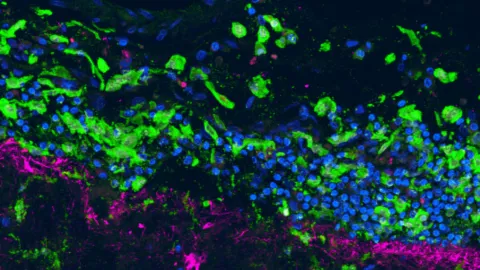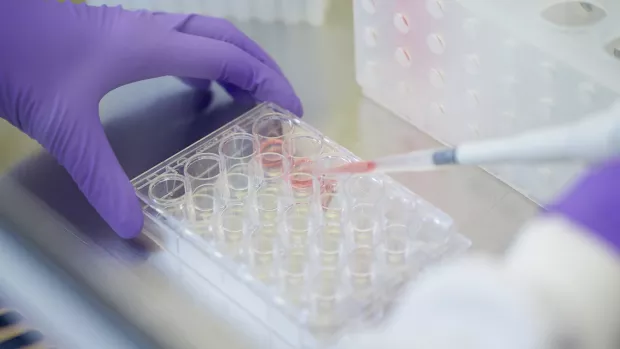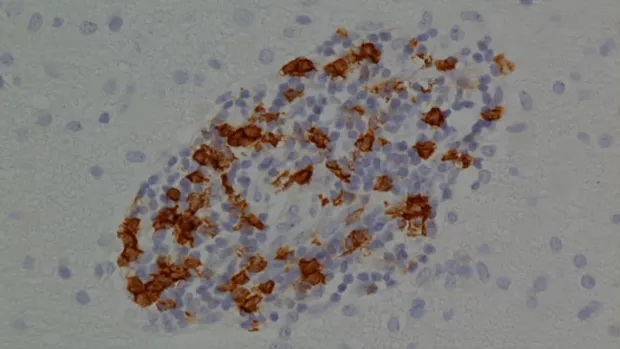
Under the microscope: meet your inner warriors
Immune cells are the heroes in the blood and brain – until they go rogue.
In MS, the immune system goes wrong and starts to attack the protective myelin coating around our nerves. Learning more about the immune system helps us develop treatments to stop these attacks from happening.
The immune system is made up of diverse characters, all with a unique role to play in protecting our bodies from harm. Here we introduce some of the most important immune cell types in MS.
T cells
How they work: T cells play a key role in defending the body from danger. Some T-cells help coordinate the immune response, while others kill infected cells.
Importance in MS: T cells have been found in lesions within the central nervous system in MS. And some T cells that can increase inflammation are found at higher levels during a relapse. Many of the current disease modifying therapies (DMTs), including work by targeting T cells.
Latest insights: Dr Anne Astier’s team in Edinburgh is investigating how T cells move into the brain in MS. They’re focusing on a protein called CD46 which doesn’t work properly in MS, and could affect how T cells get into the brain from the blood. An international collaboration led by Dr Denise Fitzgerald from Queen’s University Belfast has also shown that in mice, one type of T cell can actually help repair myelin instead of attacking it mice
B cells
How they work: Some B cells protect us by creating antibodies which trap invading infections. We also have ‘memory’ B-cells that hold a record of infections that the immune system has come across before.
Importance in MS: B cells are found in the central nervous system in MS. The presence of antibodies in the spinal fluid (often called oligoclonal bands) is one of the tests used to diagnose MS. New research suggests that B cells can activate T cells, summoning them into the brain where they can attack the myelin.
Latest insights: A drug called cladribine targets B-cells in the brain and is already licensed for relapsing MS. Now researchers at Queen Mary University are exploring whether it’s safe and effective for people with advanced MS. And in Glasgow, Professor Chris Linington and his team have uncovered a new way that antibodies could be causing damage in MS.
Microglia
How they work: Microglia are specialised immune cells that live in the central nervous system. These cells are the frontline defenders of the brain.
Importance in MS: Scientists have found that microglia play two opposing roles in MS. They can help to prevent nerve cell damage and repair myelin. But as MS gets worse, these cells not only fail to protect nerves from harm, they can also start to cause damage themselves.
Latest insights: In Edinburgh, Dr Veronique Miron is interested in proteins produced by microglia that could boost myelin repair. And Professor Sandra Amor at the University of London is particularly interested in one protein made by microglia, called TSPO. Targeting TSPO has been shown to keep nerves alive in mice. These projects could help us develop drugs that repair myelin and protect nerves from damage.
Monocytes
How they work: Monocytes are found in the blood and the fluid surrounding the brain and spinal cord. They destroy invaders and repair damaged tissue.
Importance in MS: Monocytes are found in brain lesions of people with MS. We know that the levels of subtypes of monocytes is different in people in MS, and changes when people take treatments.
Latest insights: In Edinburgh, Dr Veronique Miron is looking at the role of different subtypes of monocytes in myelin repair in mice. This could lead to a new myelin repair treatment for people with MS.
Find out about current disease modifying therapies (DMTs) that help stop immune attacks
This blog first appeared in Research Matters magazine and was updated by our Research Communications team in May 2020 to reflect the latest insights. To receive Research Matters by post please contact [email protected] about subscription.
Image: Immune cells by Owain Howell




